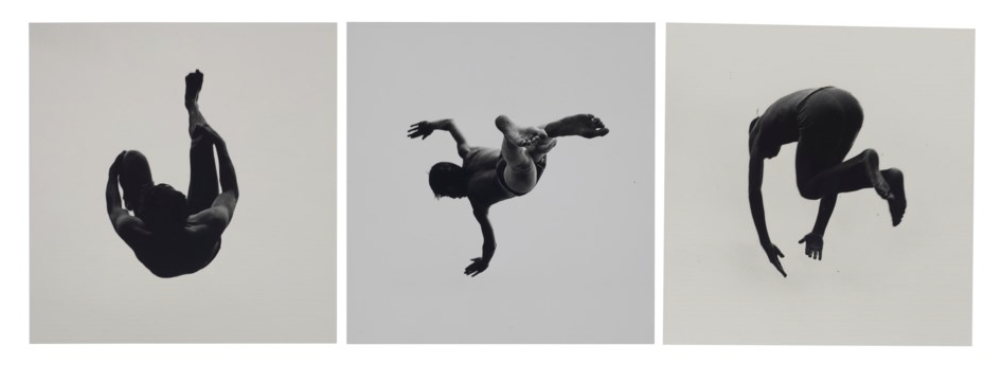#somereallygoodones, #billarmstrong, #renaissance, #muybridge, #shadowinthesun
Bill Armstrong, “Renaissance” (grid) from “Infinity” series, 2010
“We are here among people who don't contemplate transience and the existence of the soul, the meaning of life and the nature of being. We are in a world in which man, crawling on the earth, tries to dig a few grains of wheat out of the mud just to survive another day.”
― Ryszard Kapuściński, “The Shadow in the Sun” *1 (Vintage 2001)
“Renaissance” is last body of work in Bill Armstrong’s “Infinity” series. As a title, it cuts two ways. “Renaissance”, meaning 15th and 16th Century art work, identifies the source material. That is straightforward. He is working from reproductions of Michelangelo, Raphael, Pontormo, And del Sarto, et al.
And “renaissance” from the French, literally “rebirth”, demonstrates the artist’s impulse and intention. Like a sculptor, Armstrong has pared away all but the figure, letting it fly or fall or struggle. Removing extraneous detail, he gives it new life. Armstrong breathes into the darkness to reveal the shadow of man against the light, the classic tale as well as the essence of photography.
It is as if the artist has urged the “Motion Studies” of Edward Muybridge into another dimension. If Muybridge was documenting linear movement in a direct and pre-cinematic style, then Armstrong is liberating those figures from eh photographic plane. They are released into a limbo possibly unfit and eternal. He illustrates freewill and doom, delight and despair. It is our specter, once caught in the two dimensional rectangle, now let to venture out, almost from the wall.
One of the essences of art making has always been the attempt to depict and evoke our existential struggle. This search for transcendence ranges from primitive pictograms to overripe illustrations of mythologies and Biblical tales in the Renaissance and on to photographic and video art by contemporaries like Bill Viola and Michal Rovner. Robert Longo’s “Men in the Cities” dealt with this sort of imagery and in the history of photography, Aaron Siskind’s “Pleasures and Terrors of Levitation” offer a direct precedent to Armstrong’s Rorschach-like forms.
Aaron Siskind (1903–1991), “Pleasures and Terrors of Levitation, No’s 37, 48, 60”, 1953
The color is these images offers an especially compelling comment on the work. The is harder to decode intellectually, less difficult instinctively. Orange against blue, blue against red, pit one end of the color spectrum against the other. From the range, red - orange - yellow - green - blue - indigo - violet, Armstrong even offers up white against green and black on green, all very simple and controlled. There is contrast and harmony, and these elect an emotional response, the opposing colors create tension, while the adjacent colors provide a unified mood as unease gives way to relief.
Seen together, the “Renaissance” images present the escape from Eden as a chromatic hologram frieze, a visualization of Ryszard Kapuściński’s writings. *1
Armstrong’s “Infinity” series includes many different but consistent bodies of work from the “Early Figures” (1989) and “Portraits” (2001) to the “Mandalas" (2001-2007) and “Apparitions” (2007). He runs the gamut with abstraction. He achieves this by throwing information out of focus. This “blur” works as an agent of metaphor, the banal becomes potentially transcendent. Even Armstrong’s earliest images of torn posters reflect the artist’s desire to literally peel away layers to get to the core, the essence. Later works, the “Apparitions” are huge ephemeral faces that look like skulls, emerging from the darkness in some Technicolor nightmare, insubstantial yet menacing. He manages to dramatize something epic in concept rendering it in the seemingly simplest of strokes with Man, light and shadow.
Photography is a remarkable medium for this kind of epic story telling. Tales of lost souls abound in our culture. We have it in myths and legends, poems and drama, long before and long after the Renaissance.
Here is one - the beginning of Shakespeare’s “Richard III” . There the protagonist rails against his physical and human limitations, trying to sort out his destiny, having “no delight to pass away the time/Unless to spy my shadow in the sun.” *2 This could be the narrative for Armstrong's cosmic tale.
*1 Ryszard Kapuściński“The Shadow in the Sun”(Vintage 2001), (1932–2007) Polish journalist, photographer, poet and author whose personal journals blurred the conventions of reportage with the allegory and magical realism.
*2 William Shakespeare, Richard III, Act 1, Scene 1
Adapted from “Shadow in the Sun”, commissioned for “Bill Armstrong - Infinity” (ClampArt 2008) © 2008
©2021
#somereallygoodones, #theunseeneye, #wmhunt, #collectiondancingbear, #collectionblindpirate, #greatphotographs, #howilookatphotographs, #photographsfromtheunconsicous, #collectingislikerunningaroundinathunderstormhopingyoullbehitbylightning, #aphotographsogooditmakesyoufartlighting, #photographschangedmylifetheygavemeone, #billarmstrong, #renaissance, #muybridge, #shadowinthesun

